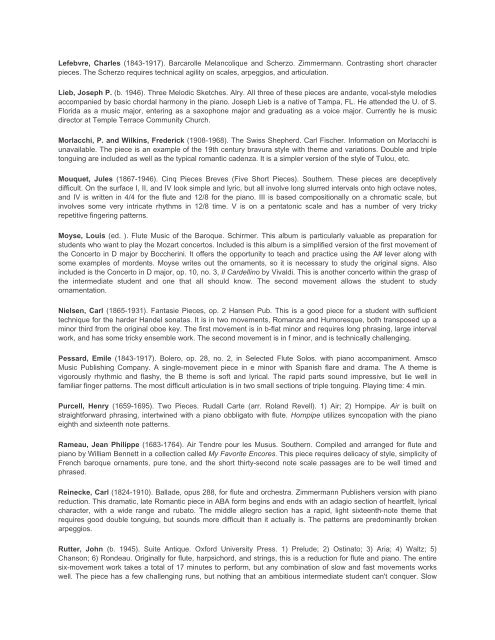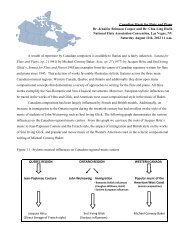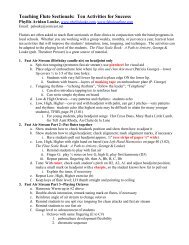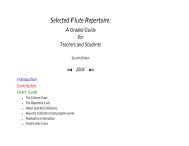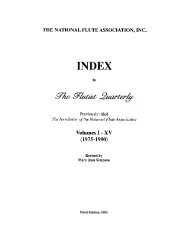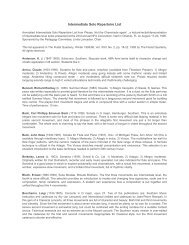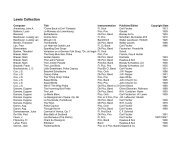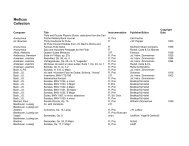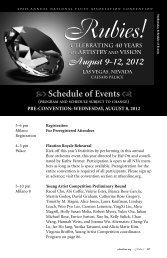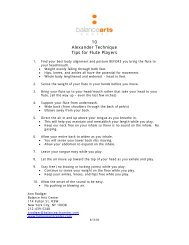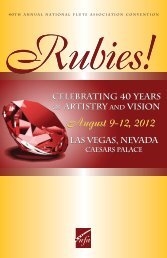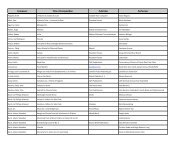Intermediate Solo Repertoire List
Intermediate Solo Repertoire List
Intermediate Solo Repertoire List
You also want an ePaper? Increase the reach of your titles
YUMPU automatically turns print PDFs into web optimized ePapers that Google loves.
Lefebvre, Charles (1843-1917). Barcarolle Melancolique and Scherzo. Zimmermann. Contrasting short character<br />
pieces. The Scherzo requires technical agility on scales, arpeggios, and articulation.<br />
Lieb, Joseph P. (b. 1946). Three Melodic Sketches. Alry. All three of these pieces are andante, vocal-style melodies<br />
accompanied by basic chordal harmony in the piano. Joseph Lieb is a native of Tampa, FL. He attended the U. of S.<br />
Florida as a music major, entering as a saxophone major and graduating as a voice major. Currently he is music<br />
director at Temple Terrace Community Church.<br />
Morlacchi, P. and Wilkins, Frederick (1908-1968). The Swiss Shepherd. Carl Fischer. Information on Morlacchi is<br />
unavailable. The piece is an example of the 19th century bravura style with theme and variations. Double and triple<br />
tonguing are included as well as the typical romantic cadenza. It is a simpler version of the style of Tulou, etc.<br />
Mouquet, Jules (1867-1946). Cinq Pieces Breves (Five Short Pieces). Southern. These pieces are deceptively<br />
difficult. On the surface I, II, and IV look simple and lyric, but all involve long slurred intervals onto high octave notes,<br />
and IV is written in 4/4 for the flute and 12/8 for the piano. III is based compositionally on a chromatic scale, but<br />
involves some very intricate rhythms in 12/8 time. V is on a pentatonic scale and has a number of very tricky<br />
repetitive fingering patterns.<br />
Moyse, Louis (ed. ). Flute Music of the Baroque. Schirmer. This album is particularly valuable as preparation for<br />
students who want to play the Mozart concertos. Included is this album is a simplified version of the first movement of<br />
the Concerto in D major by Boccherini. It offers the opportunity to teach and practice using the A# lever along with<br />
some examples of mordents. Moyse writes out the ornaments, so it is necessary to study the original signs. Also<br />
included is the Concerto in D major, op. 10, no. 3, Il Cardellino by Vivaldi. This is another concerto within the grasp of<br />
the intermediate student and one that all should know. The second movement allows the student to study<br />
ornamentation.<br />
Nielsen, Carl (1865-1931). Fantasie Pieces, op. 2 Hansen Pub. This is a good piece for a student with sufficient<br />
technique for the harder Handel sonatas. It is in two movements, Romanza and Humoresque, both transposed up a<br />
minor third from the original oboe key. The first movement is in b-flat minor and requires long phrasing, large interval<br />
work, and has some tricky ensemble work. The second movement is in f minor, and is technically challenging.<br />
Pessard, Emile (1843-1917). Bolero, op. 28, no. 2, in Selected Flute <strong>Solo</strong>s. with piano accompaniment. Amsco<br />
Music Publishing Company. A single-movement piece in e minor with Spanish flare and drama. The A theme is<br />
vigorously rhythmic and flashy, the B theme is soft and lyrical. The rapid parts sound impressive, but lie well in<br />
familiar finger patterns. The most difficult articulation is in two small sections of triple tonguing. Playing time: 4 min.<br />
Purcell, Henry (1659-1695). Two Pieces. Rudall Carte (arr. Roland Revell). 1) Air; 2) Hornpipe. Air is built on<br />
straightforward phrasing, intertwined with a piano obbligato with flute. Hornpipe utilizes syncopation with the piano<br />
eighth and sixteenth note patterns.<br />
Rameau, Jean Philippe (1683-1764). Air Tendre pour les Musus. Southern. Compiled and arranged for flute and<br />
piano by William Bennett in a collection called My Favorite Encores. This piece requires delicacy of style, simplicity of<br />
French baroque ornaments, pure tone, and the short thirty-second note scale passages are to be well timed and<br />
phrased.<br />
Reinecke, Carl (1824-1910). Ballade, opus 288, for flute and orchestra. Zimmermann Publishers version with piano<br />
reduction. This dramatic, late Romantic piece in ABA form begins and ends with an adagio section of heartfelt, lyrical<br />
character, with a wide range and rubato. The middle allegro section has a rapid, light sixteenth-note theme that<br />
requires good double tonguing, but sounds more difficult than it actually is. The patterns are predominantly broken<br />
arpeggios.<br />
Rutter, John (b. 1945). Suite Antique. Oxford University Press. 1) Prelude; 2) Ostinato; 3) Aria; 4) Waltz; 5)<br />
Chanson; 6) Rondeau. Originally for flute, harpsichord, and strings, this is a reduction for flute and piano. The entire<br />
six-movement work takes a total of 17 minutes to perform, but any combination of slow and fast movements works<br />
well. The piece has a few challenging runs, but nothing that an ambitious intermediate student can't conquer. Slow


